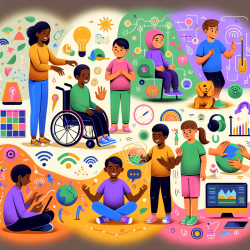As practitioners committed to enhancing therapeutic outcomes for children, it's essential to stay informed about innovative approaches that can significantly impact our practice. One such approach is the use of Multi-Sensory Environments (MSEs). A recent study titled "Disabled People or Their Support Persons’ Perceptions of a Community Based Multi-Sensory Environment (MSE): A Mixed-Method Study" offers valuable insights into how MSEs can be effectively utilized to support children with disabilities.
Multi-Sensory Environments are specialized spaces designed to stimulate the senses while providing a calming and relaxing atmosphere. These environments are particularly beneficial for children with disabilities, offering them opportunities for self-determination, enhanced well-being, and improved accessibility. Here are some key takeaways from the study that can help practitioners like you implement MSEs more effectively:
1. Promoting Self-Determination
The study highlights that MSEs support self-determination by allowing children to exercise choice and control over their environment. This autonomy is crucial for their development and can be facilitated by:
- Providing various sensory activities and allowing children to choose what they want to engage with.
- Ensuring the environment is safe and sanitized, which is particularly important for children with compromised immune systems.
- Encouraging reflection on how sensory experiences can be adapted and incorporated into home settings.
2. Enhancing Well-Being Opportunities
MSEs offer significant benefits for children's well-being by creating opportunities for social connection, improving mood, and providing a space for extended therapy. Key strategies include:
- Using MSEs as a recreational outing to interact with different people, including MSE staff.
- Observing and documenting changes in behavior and mood to tailor future sessions effectively.
- Utilizing the environment for additional therapeutic activities, such as speech therapy, when children are more receptive.
3. Improving Accessibility
Accessibility remains a critical issue, and the study identifies several areas for improvement:
- Ensuring physical access to the MSE is straightforward, including addressing issues like elevator size and room location.
- Streamlining the booking and payment systems to reduce barriers for families.
- Providing clear, accessible information about the MSE, including video tours and maps, to ease anxiety about first-time visits.
Encouraging Further Research
While the study provides valuable insights, it also highlights the need for further research to explore the long-term benefits of MSEs and how they can be tailored to meet the diverse needs of children with disabilities. Practitioners are encouraged to engage in ongoing research and contribute to the growing body of evidence supporting the use of MSEs.
By integrating these findings into your practice, you can enhance the therapeutic experiences of children with disabilities, promoting their overall well-being and development. For a more detailed understanding of the research, please read the original research paper: Disabled People or Their Support Persons’ Perceptions of a Community Based Multi-Sensory Environment (MSE): A Mixed-Method Study.










